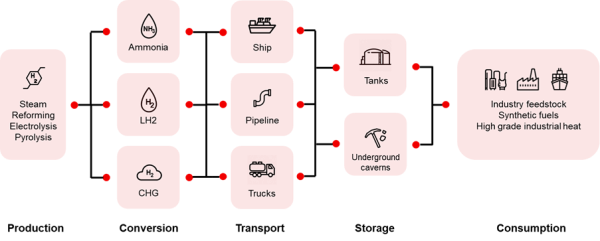Cigre Australia
empowering
networking
global know-how
Technical Brochure (TB) 942, The role of Hydrogen in energy transition opportunities and challenges from technical and economic perspectives
In searching for options to reduce the carbon intensity of our energy consumption, the main solution is shaping up to be direct electrification from near zero-emissions energy sources: mostly wind, solar, nuclear and hydro. However, direct electrification cannot entirely displace the need for an energy molecule to facilitate solutions in certain sectors like aviation and chemical industries where electrification is technically and economically unviable. Hydrogen and its derivatives are considered a strong candidate for this role. CIGRE Working Group (WG) C1.48 has produced TB 942 as a comprehensive foundation for future work on the topic of hydrogen. The Australian members on the WG were C Potter, H Samarakoon and N Sinclair.
The hydrogen system consists of production, conversion, transport, storage and consumption. All these constituents are required to form a green hydrogen economy. Each step includes a multitude of technologies, which are studied in detail in this report. Overall, this report presents the whole hydrogen system, its technologies, challenges and opportunities at each step, along with technical interactions with a hosting power system and economic considerations, providing a complete picture of the entire hydrogen chain. Figure 0-1 shows an example of such a value chain (which includes non-green hydrogen production methods).

Figure 0-1 The Hydrogen System. LH2 – liquified hydrogen, CHG – compressed hydrogen gas. Source:
Hitachi Energy.
Current estimates propose that hydrogen could fulfil between 8 and 24% of global energy demand by 2050. At this stage, the majority of the demand for hydrogen comes from industrial feedstock. In the future we can expect a more diversified demand with hydrogen used as a clean feedstock, fuel, energy carrier and seasonal storage of surplus electricity.
Use of CO2-free electricity (typically solar and wind) in electrolysers located as close as possible to the final consumption is the most efficient and economic option for having CO2-free hydrogen. However, large renewable energy and hydrogen production facilities require substantial physical space, and most likely at least some grid expansion. Large scale facilities may be challenging in the vicinity of the large urban and industrial centres.
Getting hydrogen from global production sites to end users at the lowest possible cost will be the key to the success of a green hydrogen economy; transport and storage can be realized through several modalities (land, sea, underground) and through conversion to other molecules, easier to be moved around and stocked. The modality, distance and volumes of hydrogen transportation and storage can have a big impact on the levelized cost of hydrogen to the consumer.
Exploiting the decarbonization potential of hydrogen, means installing huge capacities of electrolysers, with relevant costs, incentives, financing and permitting issues. This array of large electrolysers (expected at GW scale) requires proper integration into the grids, entailing several challenges as well as new opportunities where electrolysers can become a source of flexibility for both short and long-term flexibility needs. Integration of hydrogen into the system has an impact both on grid planning and on grid operation. This will require strong coordination under a common framework of infrastructure planning to maximise the benefits and minimise the cost.
Conceptually, the flexibility of hydrogen electrolysers can better utilise the low-cost variable renewable energy sources. However, the conversion processes needed to store or efficiently move the hydrogen are often less flexible. Efficient use of capital will also be a determining factor in the overall flexibility of the plant. Nevertheless, capturing the potential of flexible hydrogen operation will play a crucial role in limiting the cost of production.
Hydrogen transport increases cost: ideally production of hydrogen should be close to the end-use points. However, this is not always practical. Equally, depending on transport modality, hydrogen networks can help manage constraints on expansion of electrical transmission grids while still achieving emissions reductions in the face of increasing energy demand. In the case of bulk and long-distance energy transport, especially if marine paths are involved, hydrogen transport can be cheaper than marine electric cable. There may be options to cost effectively repurpose existing gas pipelines.
The TB provides an overview of government policies and implementation approaches in various regions. It notes that currently, the United States and the European Union lead the hydrogen policy action in terms of building a fully-fledged hydrogen economy. This is discussed in detail along with strategies of several other countries. Other regions of the world such as the Middle East, North Africa, Iceland, Australia, Central Asia and Chile, are aiming to become (or remain if now based on fossil sources) energy exporters.
The TB is free for members and 300€ for non-members.
